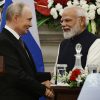India and Russia are planning to introduce a reference exchange rate of the rupee to the ruble to bypass dollar barriers, the Indian daily Economic Times writes about the idea. The publication's sources claim that the issue will be discussed at a meeting of high-ranking representatives of regulators and commercial banks in Moscow in the near future. Currently, the parties settle accounts in national currencies, credit institutions are forced to use dollars to process export and import payments.
But for now the parameters of this conversion are not transparent, explained Sergey Polyakov, Deputy General Director of the international company Holding Finance Broker: «At the moment we send rubles to India, where they are converted into rupees at a slightly inflated rate, because there is no mechanism, and banks use this to the detriment of payments in Russian currency. Now a certain structure is being created that will coordinate these rates. I think that this will still happen through the dollar, or through the euro, or through the dirham. Meanwhile, India already has a similar agreement with the United Arab Emirates.
Ultimately, a more or less reasonable rate will be determined, and banks will not speculate too much on the fact that we need to make some urgent payments.”
Using a reference exchange rate will help resolve the issue of so-called frozen rupees for exporters, but it will be a problem for the Russian regulator, since it is still unclear how these reserves of Indian currency can be spent, noted independent expert on the payment market Dmitry Vishnyakov: “A problem is emerging: the exporter receives money from India, but there is nowhere else to spend it except on the domestic market of this country.
Now, apparently, the Central Banks are agreeing that the Russian regulator will buy rupees at a rate that will be reflected in rubles, and not in dollars or another currency, as was the case before.
Such mechanisms exist only with small trading partners for India — the UAE, Nepal, Bhutan. Sri Lanka has expressed a desire to do the same. At the same time, the Russian Central Bank will have a limited choice of operations, since the volume of money is quite large, and the regulator will have a question about what can be bought in other countries that want to accept rupees, for example, in China. The republic's trade turnover with India is also at a high level. But Beijing will probably want a certain discount for this.»
The problem of «frozen rupees» arose due to a trade imbalance: Russia sells goods to its partner for $60 billion a year, and buys from it only for $4 billion. Settlements are made in Indian currency, but Moscow has nowhere to put the difference, since there is practically nothing to buy in the republic, former Finance Minister Mikhail Zadornov explained earlier. In April, Russian financial organizations asked New Delhi to allow investing «frozen rupees.» They were invested in stocks, government securities, infrastructure projects and other assets. Thus, Russia invested «billions of rupees», local media wrote.
.
























































Свежие комментарии